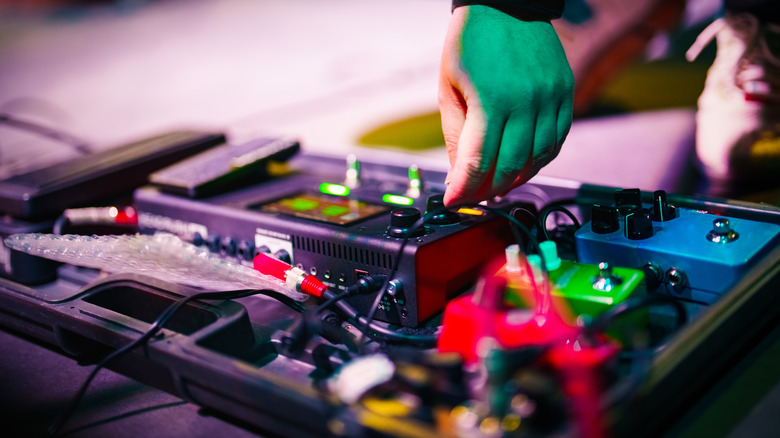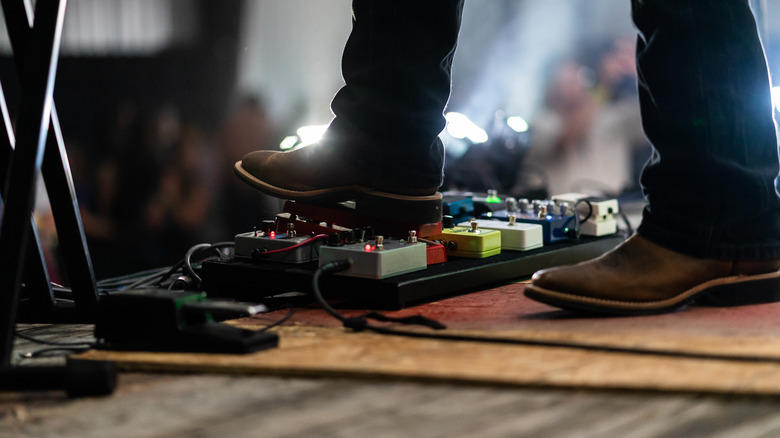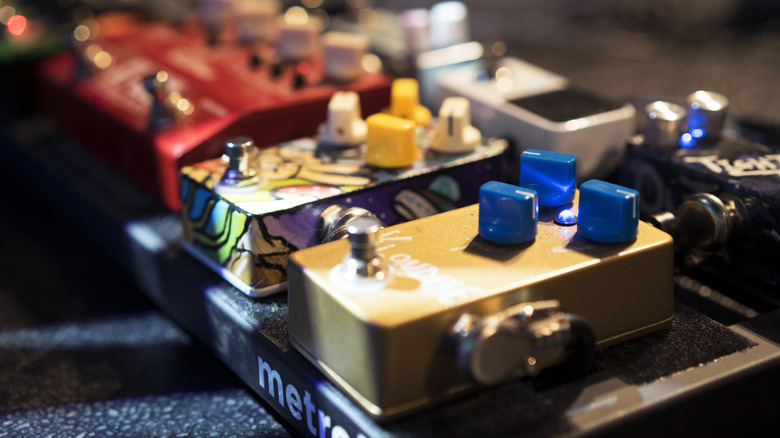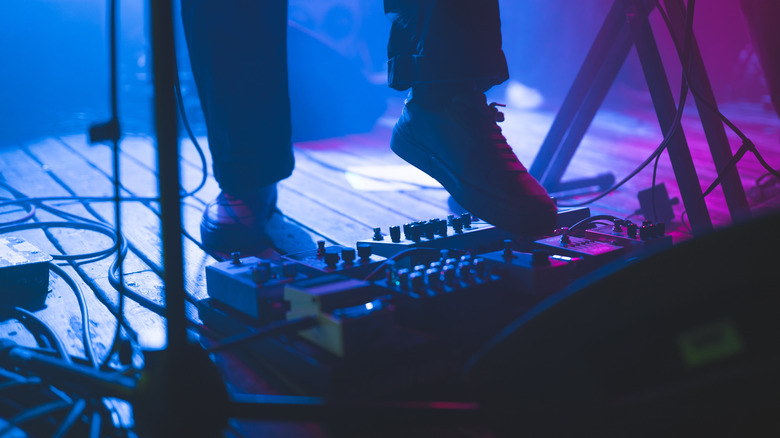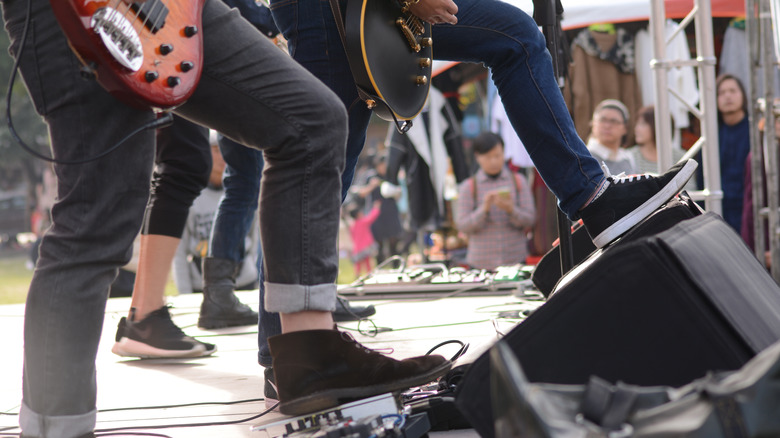How To Choose The Right Power Supply For Your Electric Guitar Pedalboard
For most guitarists, having the perfect pedalboard setup is very important. Of course, others are perfectly content with an acoustic guitar or plugging their favorite electric guitar directly into the best amplifier for their needs to play the instrument how it naturally sounds, but the versatility with which you can utilize a guitar with a series of pedals is staggering. Whether you're using them for delays, looping, pitch-shifting, fuzz, or anything else, pedals are about as important as the guitar itself, and it doesn't matter what genre of music you are playing either.
Going to the store and picking up a bunch of pedals isn't the only thing that goes into a pedalboard. You can have them set up in the perfect configuration for how you like to play, but these pedals won't do anything unless they are getting power. You are working with devices that need electricity, but if you have a setup that includes eight pedals on it, you are going to have a tough time find a wall outlet that can fit all those plugs and handle all that power. That dilemma is made even more complicated when you are on the middle of a stage.
What you are going to need to do is pick up a power supply brick to consolidate and regulate the power of all your pedals. There are different kinds of power supply bricks out there, so you need to keep a couple of things in mind before you purchase one.
Know your voltage
Arguably, the most important factor in determining which power supply brick is right for your guitar pedalboard is knowing the voltage requirements.. Depending on multiple factors, you could have a variety of different voltages necessities that you may not have even realized when you purchased them, and not every power supply will be able to accommodate them.
Luckily, most pedals tend to use a 9V power supply, and most of the bricks on the market are made for these 9V pedals. Finding a power supply for these pedals will be fairly easy. However, not every pedal is a 9V pedal, and you could have pedals that reach upwards of 12, 18, or even 24V. These simpler 9V power supplies just won't work. This doesn't mean you have to get one power supply for your four 9V pedals and two 18V pedals, for example. There are power supplies out there that support multiple voltages within the same brick, either by having designated outputs for certain voltages — as each output is isolated — or by having variable outputs that allow several different voltages.
To figure out what voltage your pedals are, that information is either printed directly on the pedal itself or found in the manual. If you have purchased a used pedal that comes with no manual and the number has been scratched or worn off the pedal, take to the Internet to find out, as some guitar fanatic out there has probably answered the question.
Know your milliamps
The amperage of your pedals is also of the utmost importance when figuring out which power supply to choose from. What this number tells you in milliamps (mA) is how much power is required for the pedal to actually work. For example, a pedal could need 10 mA to function, but others could need 500 mA. This all depends on what the effect is and particularly when it was made, as modern digital effect pedals require a good deal more milliamps to function.
Just as the voltage for these power supplies are typically isolated between outputs, that is the same for the amperage. However, having a certain voltage does not mean you are going to have a corresponding number of milliamps of current. A 12V output on a power supply doesn't automatically mean a maximum of 200 mA. It could be 100 mA. It could be 500 mA. That being said, if your pedal requires 100 mA of current and you connect it to your power supply that reads 200 mA, that is fine, as the number on your pedal just indicates the minimum amount required. If your pedal needs 500 mA with that same 200 mA, you will be out of luck.
The amperage of your pedals will usually be located right alongside their voltage requirements. To play it safe, look for power supplies that have higher amperage, because you never know what kind of newer, high current pedals you could pick up and add later.
AC or DC
You do not need to just know how much power is required for your pedals to operate, but you do need to know exactly what kind of power is needed. Specifically, you need to know if your pedals run on alternating current or director current — AC or DC for short. Just as 9V pedals tend to be the most common out there, the same can be said for DC powered pedals. Majority of power supplies out there will also be DC power.
Of course, it can't be that easy. Though they are rarer, there are still a decent number AC pedals out there, whether they be tube circuit pedals or older digital ones. Either you can get a smaller AC-only power supply for these pedals, or you can pick up a power supply that is mostly DC power but may have a couple — or just one — outputs for AC power, like the Truetone 1 SPOT PRO CS12. AC power still requires you to know the proper voltage and amperage of your pedals too, so not every AC output on the market may be right for you.
How many pedals do you use?
So, you have figured out all the voltages, amperages, and technicalities about your pedals and set them all up on your pedalboard. Now, you get to answer what is probably the simplest question you need to ask about your setup: How many pedals do you use? Once you have counted your pedals, you now know how many outputs you need for your power supply. There is no standard number of outputs that a power supply has, and there isn't even a standard of having an odd or even number of outputs.
While this means you can get a power supply where you have the exact right number of outputs for your pedals, there is still some negotiation that has to happen when looking for them. You may have seven pedals on your pedalboard, but if you have three 9V, 200 mA DC pedals, two 18V, 200 mA DC pedals, one 18V, 500 mA DC pedal, and one 9V, 200 mA AC pedal, you can't just grab any 7-output power supply. You still need to find one that fits all of your requirements, which may mean selecting one that has 12 outputs because it's the only one that works. Also, you could always add to your pedalboard in the future, and having a few extra outputs in that power supply could come in handy without having to buy another one.
Where are you performing?
Last — but certainly not least — you need to think about where you plan on using this pedalboard. With all the power considerations about how this power supply gets the power to your pedals, you also need to think about how the power gets to your power supply, and that changes dramatically depending on which country you are in, as the main power supply changes wherever you go. For something like this, it also isn't a matter of you getting an adapter that you attach to the plug that you put in an outlet.
So, if you see yourself traversing the world and not wanting to buy a new power supply at every stop, you will need to pick up a power supply that can handle different power inputs. There are really two kinds of power supplies: Linear and switch-mode. Linear power supplies are your more traditional bricks that musicians have been using for decades, while switch-mode are newer and typically allow you to alter each input for different voltages and amperage for your needs. These also happen to be the power supplies that work all over the world without issue.
Linear and switch-mode power supplies also have differences in their weight and the noise the generate, but the major distinction comes from how versatile they are. Going on a world tour means you should probably be looking at switch-mode power supplies.
